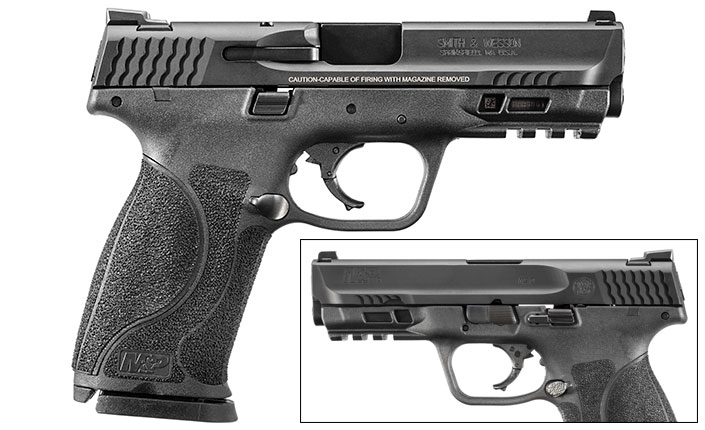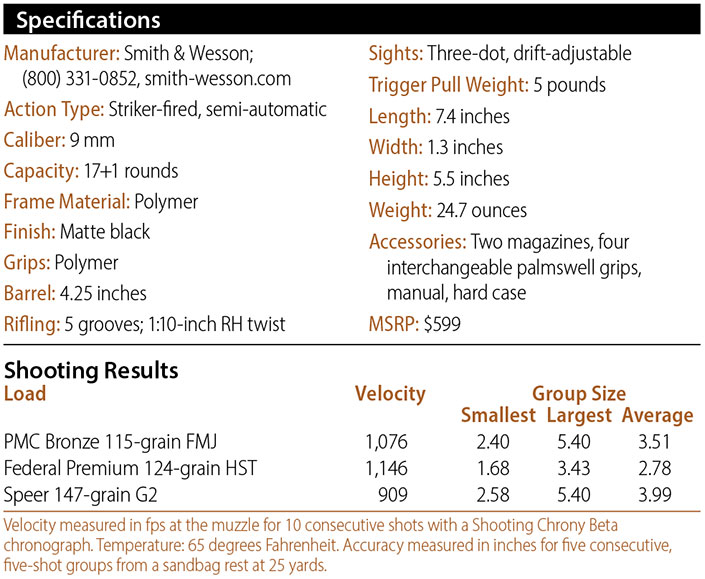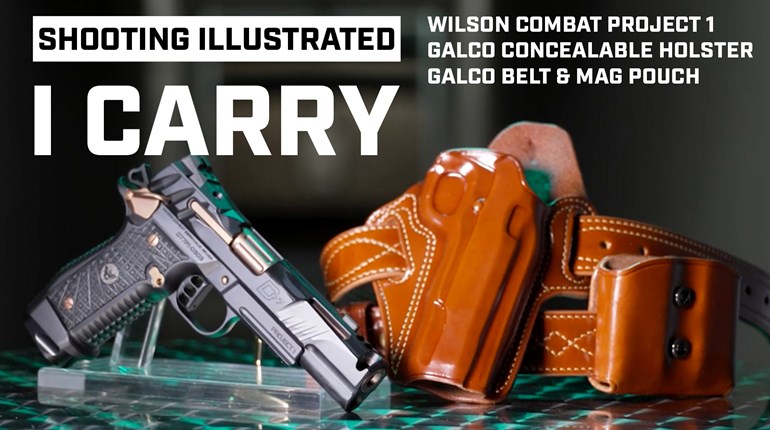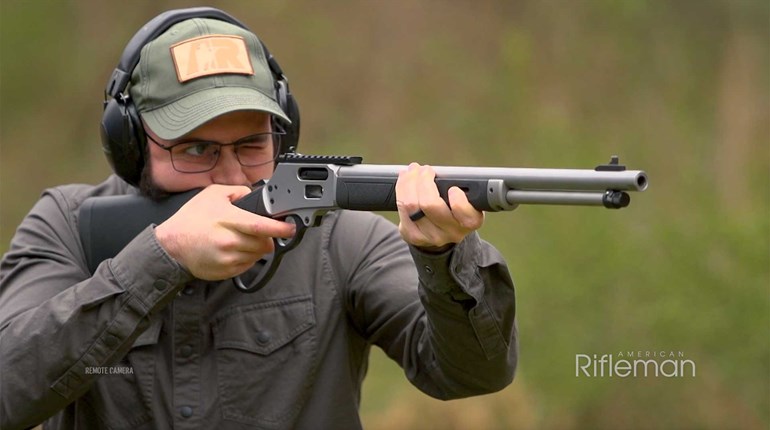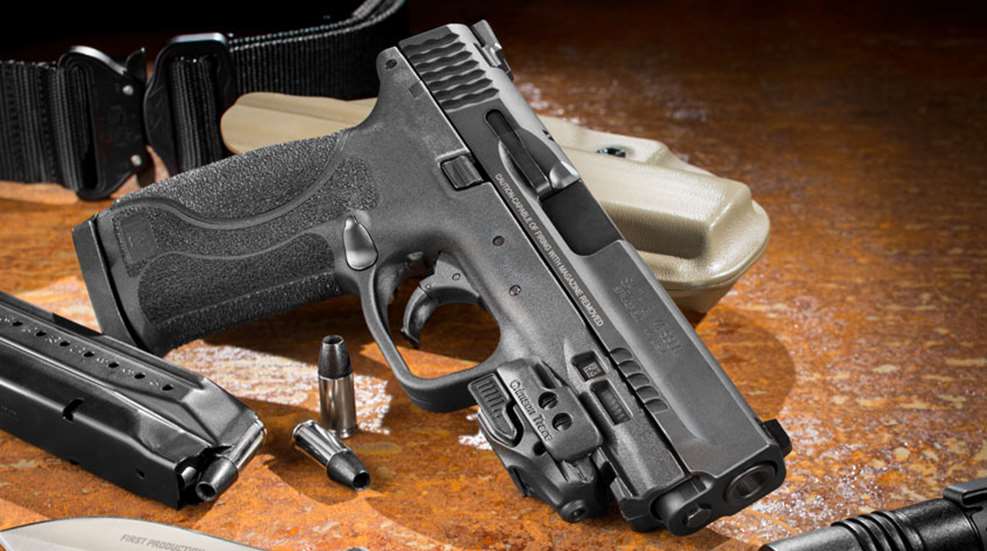
The Smith & Wesson M&P M2.0 is pictured here with GBW Cartridge ammo, a High Threat Concealment holster. a Crimson Trace RailMaster laser and a Blackhawk belt.
The close of the revolver era in American law enforcement handguns saw Smith & Wesson dominant. When the shift began toward semi-automatics in the 1980s, the company’s biggest domestic rival, Colt, effectively removed itself by not having an offering in the category, and Smith bestrode the market like a colossus...for a little while.
The 1990s saw it continuously losing market share to the upstart company from Austria until, in the early years of this century, the Massachusetts-based manufacturer somehow found itself the underdog in the market segment it used to own. The problem was that Smith & Wesson’s classic service semi-autos were extremely expensive to make relative to the modern polymer wonderguns. Combine that with the ease of training offered by the single trigger pull of the striker-fired action and the lighter weight of the guns themselves, and it was obvious there was no choice but to try and join ’em if you wanted to beat ’em.
After a bit of initial flailing, Smith hit back in 2005 with the release of a new striker-fired duty pistol, and mined its decades of dominance in the field for the name, calling it the “M&P” for “Military & Police.” This was the same nomenclature used for the Model 10 revolver that was synonymous with “duty gun” for so many decades in U.S. law enforcement, and it served as a clear signal of intent.
Being second to market means you can look at your competition and try to best them by correcting their shortcomings, and the new M&P did exactly that. It was designed from the ground up with the stresses of the .40 S&W chambering in mind, unlike most duty-grade .40s at the time, which were more or less simply re-barreled 9 mms. It featured multiple interchangeable backstraps, so that it could be tailored to fit the hands of a variety of different-size users. Lastly, and most directly aimed at the competition, it could be disassembled without having to pull the trigger.

Smith & Wesson started retaking lost ground, and the M&P series was a huge success, but the game isn’t static and its Austrian rival released a refreshed version of its basic pistol and it was only a matter of time before Smith followed suit with the Smith & Wesson M&P M2.0.
The M&P M2.0 dropped at this year’s SHOT Show in Vegas, boasting a host of small refinements that added up to a seriously improved version of the original. Your faithful scribe got her hands on a basic black M&P M2.0 in 9 mm to test. Since I carried an original M&P 9 mm for many years, I was curious to see what changes Smith & Wesson made to the platform.
Let’s open with what didn’t change: The basic size and shape of the pistol is the same. If you’re invested in a ton of M&P holsters, they still work with the Smith & Wesson M&P M2.0. I even tried my Raven Concealment Systems Vanguard2, which is a little clamshell that pops over just the trigger guard, and it still functioned with the new pistol, indicating that not even the shape of the trigger guard has varied significantly. This is a good thing.
Another thing that didn’t change is the magazine. The M2.0 can make use of your existing stock of standard M&P magazines, which is handy if you have a whole shoe box full of the things already. I start getting itchy if I have less than 10 mags on hand for my carry gun, because a bunch of mags can make things much easier at classes and matches and such.
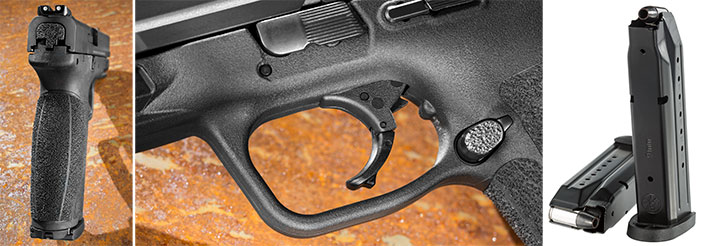
Between a good supply of magazines and a couple of holsters, the notion of changing or upgrading carry guns can be daunting, since the support gear can approach or even exceed the actual cost of the gun. Being able to continue to use your current stuff would make the upgrade path a lot more user friendly.
Also the same: The internal sear-release lever for takedown, so that the pistol may be fieldstripped without having to pull the trigger. Love it or hate it, this is where a lot of unintended loud noises happen with the Glock, and Smith has engineered a way around it that appeals to some users. So, what’s different? Well, a lot more than was readily apparent.
The obvious differences include new abbreviated forward cocking serrations on the Smith & Wesson M&P M2.0. These are only on a narrow horizontal strip on the front end of the slide, but since it’s also the widest part of the slide, they make a lot bigger difference in purchase than I figured they would. Another difference is the lack of a beavertail tang on the frame, presumably to meet overall length requirements for Smith’s attempt at the Army’s M17 contract. Instead, a beavertail is included on the two largest backstrap inserts, which have been increased from three size options to four. The frame is now more aggressively textured, to the point that if a large part of my income came from doing aftermarket stippling jobs on M&Ps, I’d think about diversifying because this gun probably doesn’t need it; it’s that “grippy.”
Less visible are changes to the slide-release lever, which now features a spring-loaded detent, and the trigger that is lighter and has a vastly more noticeable tactile and audible click on reset.
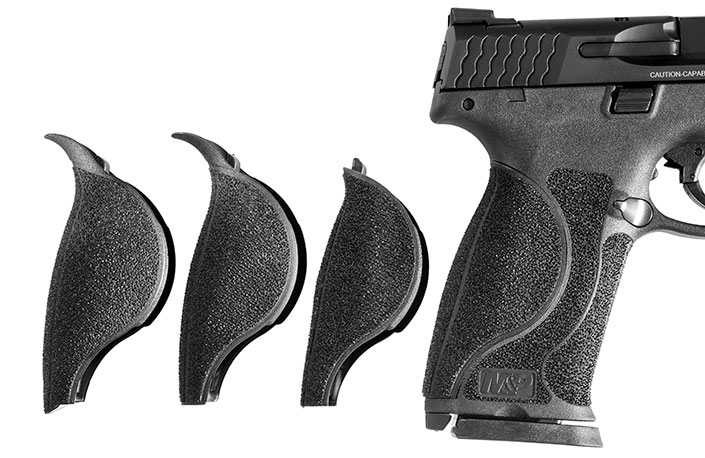
The spring-loaded detent on the slide-stop lever of the Smith & Wesson M&P M2.0 is intended to prevent “auto-forwarding,” or the propensity of the slide to drop prematurely when met with the inertial forces of slamming home a full (read heavy) magazine in a lightweight polymer pistol. Some people seem to think that’s a feature not a bug, but that’s because their gun hasn’t auto-forwarded onto an empty chamber. Yet.
Smith’s new slide-stop detent design pretty much renders that an impossibility. I tried seating a magazine with a +5 floorplate full of 147-grain ammo with enough force that I was worried I was going to have to buy the broken handgun when I was done, and the slide didn’t drop—even when I tried several more times.

Moving to the trigger, and it is a lot better than the original version. People used to pay money to the aftermarket to get their M&P triggers the way the Smith & Wesson M&P M2.0’s comes out of the box. Not only is the reset more positive, but the take-up doesn’t feel like there’s a dish sponge somewhere in the lockwork. Right out of the box the trigger pull measured a consistent and repeatable 5 pounds, which is a quarter-pound lighter than the well-broken-in trigger on my old carry gun with probably close to 10,000 rounds of live-fire and years of dry practice on it.
The steel “chassis” which cradles the lockwork and forms the frame rails extends further forward on the new gun, and is intended to reduce problems with the frame flexing under recoil, especially when various accessories are clamped to the Picatinny rail on the dustcover. The new pistol weighs a little more than the old one as a result, measuring 27.8 ounces empty on my postal scale and 35.8 ounces with a full payload of 18 Speer 124-grain +P Gold Dot hollow points.
So, how does it shoot?
In my youth, film critic Eleanor Ringel reviewed the James Bond movie, “A View To A Kill,” by saying “Going to a James Bond movie is like going to the zoo. Either you’re happy to see the giraffes again or you’re not.” The temptation is there to say that about a trip to the range with the Smith & Wesson M&P M2.0; it’s not fair, though, in that there were things people might not like about the original M&P that this new version might have corrected.
The trigger would be the first and foremost. Even being rusty with M&P’s in general, I shot the M2.0 pretty much as well as the Glock G17 I carried to several classes last year. It sits low in the hand, and the lengthened steel chassis does seem to help a bit with muzzle rise. I fiddled with the different backstraps, but found to my surprise that the vanished beavertail didn’t really bother me and the medium backstrap that shipped mounted on the gun worked best. The trigger was, for me, old-home week, since I’d spent so many years with the two-piece hinged trigger of the original M&P. To folks not as used to it, the sharply curved trigger with the hinge in the middle felt strange, but the proof was in the shooting, and they shot it just fine.
Shooting from a sandbag rest with the Smith & Wesson M&P M2.0, we tried some groups at 25 yards and were rewarded with quite satisfactory results. A couple of groups were opened by fliers, but across three different brands of ammo and three different projectile weights, the average size of 15 groups was probably not much over 3 inches, and that’s even including the fliers in the average. One group from the standard-pressure Federal Premium HST was smaller than 2 inches, and bear in mind that these were just the random brands of ammo I had in my “test ammo” military-surplus ammo can that spends its time rattling around in the trunk of my car.
Steps seem to have been taken to ensure that full-size M&P 9s shoot OK. I approve.
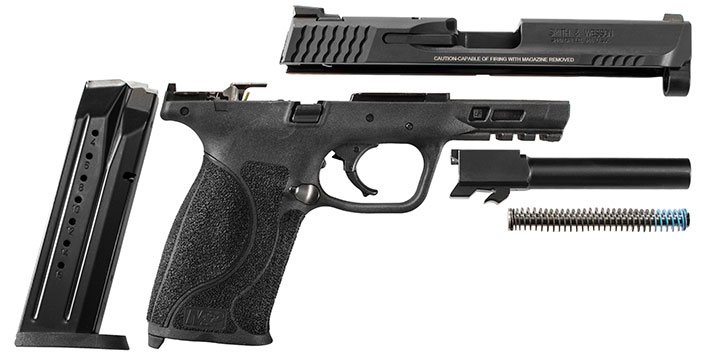
“So what’s the verdict, Tam? Should I sell everything and run out and buy one?”
If you’re carrying an M&P that you already sunk a ton of aftermarket money into? I dunno. It’d be kind of awkward, since this is essentially the equivalent of an M&P that comes out of the box with a ton of aftermarket money sunk into it already. If I were still carrying a stock M&P, however, I’d be on this thing like a hungry kid on a Twinkie, and I’d relegate my original M&P to spare-gun status rather than sink money into aftermarket mods.
If you’d passed up on the M&P in the past, for whatever reason, it might be worth your while to go check out a Smith & Wesson M&P M2.0. It may look the same, but it’s a lot more different than it looks.
